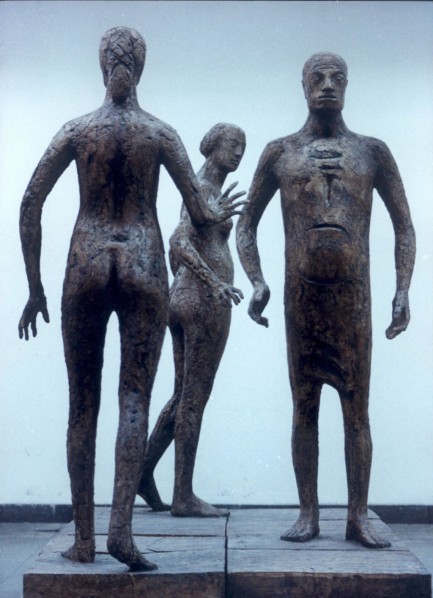
Zhan Wang's Graduation Work, Streets, 1988; oulopholite, life size
by Liu Libin
Part IV Conceptual Sculpture
Since ‘style’ is retired, whether there’s any meaning of the ‘root’ in Chinese sculptors such as creating habits for ‘sculpture’ skills, is there then any pleasure of touching the clay and the obsession with it and fiber reinforced plastic and bronze? If ‘Style’ is retired, then what manifests itself?
When he was studying at the training school, Zhan Wang was the student with the best ‘sense of sculpture’. Afterwards, Zhan Wang indulged in the progress of molding a body by clay. It’s difficult for him to throw away such an ancient and traditional method because there’s a pleasure in the creation when he is molding parts of human body — in making a draft, he can change it any way he wants. The progress can guide him into a world of fantasy and imagination. In the period of creating with superrealism style, Zhan Wang said, only by removing the imitated ‘style’ then “Audiences would be attracted by your idea and pay attention to your concept. It can be said that this is the first time I had the consciousness to be conceptual in art.”
What is concept, then?
In the world of art, some people interpret concept as a continuous creative idea, some regard it as the starting point (reason) of a specific art creation and some regard it as focus (key word) of a specific work. Though they all continuing with the logic of epistemology: “Conceptual things are merely things transmitted from outside to people’s minds and materials reformed in people’s minds.” (Karl Marx). The problem is, does an artist express a concept through art creation or guide their practice through a concept? What kind of a relationship lies between the preconceived concept and resulting concept and art creation and art appreciation? How does Zhan Wang define his ‘conceptual sculpture’?
First of all, how does he deal with the ‘skill’ he once obsessed with? Differing from general views that ‘skill’ and ‘concept’ are separate, Zhan thinks skill itself is thinking (concept). He thinks, in practicing ‘conceptual sculpture’, the most important thing is how sculptural skills are shifted to concepts? And how concepts are materialized in technical methods? He thinks ‘conceptual sculpture’ is the organic combination of concept and material, it’s an indispensible whole, while the skill of sculpture he learned before is the bridge to connect the two. It changed the traditional habit that contradicts skill and concept.
I had expressed a similar opinion in the preface to Zhan’s “Sculpture” exhibition. One of the reasons I named the exhibition “Sculpture” is to emphasize countless relationships between ‘non-sculpture’ and ‘academic sculpture’. Being different from the general view that focuses on the new art form of ‘non-sculpture’, I focus more about the connection of Zhan’s work with academic sculpture. His other purpose is to emphasize the verb inclination of the noun ‘sculpture’: ‘carving’ and ‘modeling’ and purposely stress the value of hand work in the sculptor’s daily work. ‘Carving’ and ‘modeling’ can be regard as a basic skill of sculpture. When the art form ‘sculpture’ is reduced to its’ original level, is it possible to vitalize its possibility? When the most basic handcraft of an art form manifests itself again, whether the shelter in the evolving progress can be instantly stripped ? Whether the ‘physicality’ of the material the artist used could be vitalized? Such ‘physicality’ contains quietness and intrepidness of academy and calmness and steadiness to confront the uproar and impetuous of the art world.
It was in works of Zhan Wang’s such as “Sidewalk”, “Sitting Girl” and “Woman Lost-weight” we can see such possibility: the sculpture skill connects the possibility of concept and material. The work concentrative represented such exploration in his work exhibited on his solo exhibition “Empty Soul Empty: Temptation Series” (commonly known as ‘The Mao Suits’) in April 1994. In this work, Zhan continued creating superrealism style using a traditional sculpture skill. The empty shelled ‘Mao suits’ had surreal actions (reminds people of the embarrassing moment of the girl stands up at the first menarche of “Sitting Girl” and the moment the woman fell down in “Losing Weight”). Critic Li Xianting thought the “brilliance of the work lies in the realistic drapery that presents some real and ridiculous relationship between the physical sense and the shell.”
The ‘physical sense’ is in fact produced by Zhan’s way of creation. He molded the ‘Mao suits’ using traditional sculpture methods and therefore endowed a strong ‘sense of material’. Then he creates a ‘conceptual sculpture’ (or so-called ‘installation’) of the typical standard through construction at the location. If “Sidewalk”, “Sitting Girl” and “Woman Lost-weight” marks the point when Zhan Wang entered into first creation period, then “Mao Suits” marked his entering into another creation period. At this time, he was farther and farther away from “New Generation Painters”. As a sculptor Zhan Wang based his particular states of sculpture in China, fully using the tradition of sculpture on one hand, and the expanded extension for ‘sculpture’ on the other, while endowing a more contemporary meaning to ‘sculpture’. In his own words, it’s ‘conceptual sculpture’.
Zhan Wang concluded his creation of this period: “Since history didn’t give us a privileged right to experiment on this issue, shall we experiment new possibility of art on the shoulders of our predecessors? This is the earliest thought before ‘materialized concept’ was brought about later… Therefore I present my opinion that skill is concept, uniting two contradicting matters and expressing concept in the skill of art and nature of material. Therefore there is conceptual sculpture… As a matter of fact, when an artist creates works, usually there is a feeling that initially goes, if there’s an explicit concept at first; the work shall be the interpretation of the concept, the theory is the concept of evidence is misinterpreted most of the time, many people later treated the conclusion of a successful artist to their work as a predetermined concept. These works, no matter how they are interpreted theoretically, they can hardly avoid being visually dull. This is why I have to emphasize visuality all the time, because it’s the best way to get rid of the temporary empiricism.”——My Experimental Art Journey, 2004.
Part V Confronting Reality: Zeroing for the Second Time
If realizing “You too lose sometimes!” , is going from an ‘aerial view’ to an ‘eye level view’ to being the first change of Zhan Wang’s life state and thus led to ‘zeroing’ on art style. ‘Confronting reality’ is the start of his existence in almost a ‘zero degree’ way and observing the world and analyzing the world as a ‘bystander’ after his illness. The former ‘zeroing’ is his art style; the latter ‘zeroing’ is him subjective. The former ‘zeroing’ happened in the first half of the 1990s, the latter ‘zeroing’ still continues. When analyzing “Empty Soul Empty: Temptation Series”, critic Yi Ying wrote “this is not a formalism progress, but a result he regained from the nature of humans when he expressed the subject of a human to the society. Also the variation of form is not only a result of formalism exploration, but spiritual sublimation after tribulations and fission of reality.” In my view, ‘spiritual sublimation after tribulation and fission’ Yi Ying said is the change of Zhan’s life state, but I don’t think it’s the begging of Zhan Wang’s accusations that are based on humanitarianism but appearance of his annalistic inclination based on calm observation.
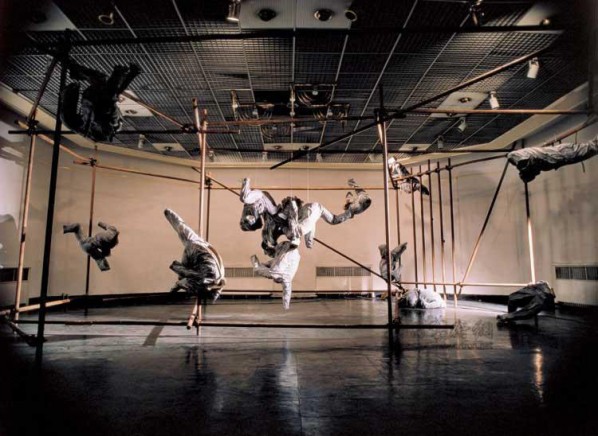
Zhan Wang, Empty Soul Empty Temptation Series(1993--1994)
“Empty Soul Empty: Temptation Series” contains obvious political metaphors, the work was created and exhibited in 1993 and 1994. When I asked the reasons of Zhan Wang, he replied “As it was too close to 1989, I couldn’t respond because I was involved… at the time we were beneath hell… I regard it as a turning point.” Keeping a distance on time is waiting for a settlement of emotion, Zhan stayed awake to the instant response at the time.
In 2002, Guangzhou Art Museum held “The First Guangzhou Triennial, Reinterpretation: A Decade of Experimental Chinese Art (1990-2000)”. Zhan Wang wanted to exhibit his “Rockery Stone”, Wu Hung insisted on exhibiting “Empty Soul Empty: Temptation Series”. The final result after negotiation was that Zhan Wang decided to exhibit “Empty Soul Empty: Temptation Series” and bury the work beneath the Guangzhou Art Museum after the exhibition. The first Chinese contemporary art triennial was ended on 19th January at 2 o’clock in the afternoon, Zhan Wang practiced his plan of burying the shells of the Mao Suits and placed a tombstone engraved with “Zhan Wang’s work Shell of Mao Suits is buried here.”
Burying “Mao Suits” is in fact an avoidance and refusal on a creation dimension. In the passage Subject Examination and Realism Transcending of Chinese Landscape Painters I pointed out that the “Historical context of 20th century is filled with a breath of ‘modernism’. In the first half is the crisis of the existence of a nation and the demands of building a new country; in the latter half the existing creation basis of landscape painters was doubted by the ideological environment and demand of art as a tool. To examine this seriously, this doubt is an overthrow to the existing mode of the existence of landscape painters. The success of revolution and movements usually requires the breaking of individual world, involving everyone in the tide of revolution. In such a coerced fate of the time, most landscape painters lost persistence to self subjective and conducted practical coping creations.” Landscape painting is in the same situation, and the 30 years of “Chinese Contemporary Art” in a general sense is also emphasized on practical pertinence level, criticality and reflection are at its’ most important dimension. Certainly such art creation has an important social meaning, and many brilliant works appeared. But the single dimension must have a problem. Although Zhan Wang’s “Empty Soul Empty: Temptation Series” didn’t appear too much of a ‘transcendence’ feature (even more conformed with ‘critical’ standard of ‘contemporary art’ we mentioned today), his grasp of a creative opportunity and his burying of the work in 2002 appeared as a clue of his refusal of such a ‘coping’ art.
The reason Zhan Wang appeared in such an attitude is closely related to his judgment on reality. In 1994 Wangfujing Street of Beijing started a large scale demolition, Zhan realized that an industrialized reformation was about to come, nobody and nothing could avoid it; it overshadowed all ideological entanglement and misery along with the despair produced in the entanglement. Based on such judgment, he decided to change his view of the world and wished for a more objective and constructive view on the relationship between man and society. The work “94 Clean Ruins” was produced during this period. Later when Zhan Wang wrote his “Summary of 2010” he said “Witnessing our country entering prosperity and the progress from so many disasters and hardships, it’s like the turning of a giant, such a huge transition. As a university graduate of the time, the revolution almost synchronized with the country and realized everything in life with it. Art academy and society gave us a huge platform, our thinking and expression reformed as the country reformed, but the basic principle never changed, that the desire from progress and prosperity came from bottom of the heart. On this point I believe all Chinese people have a personal experience.” In contrary with many artists with practical criticism, Zhan Wang presented a more capable vision of affirming reality.
In his later works, Zhan Wang continued presenting his attitude of trying his best to confront objectively and analyze reality, history and even religion. In these creations, he basically implemented ‘the doctrine of the mean’ he understood: not biased, not insisting on a certain pole, viewing the whole and confronting it directly. The following works are produced in such a frame (quote from “Work Introduction” of Zhan Wang’s website, edited).
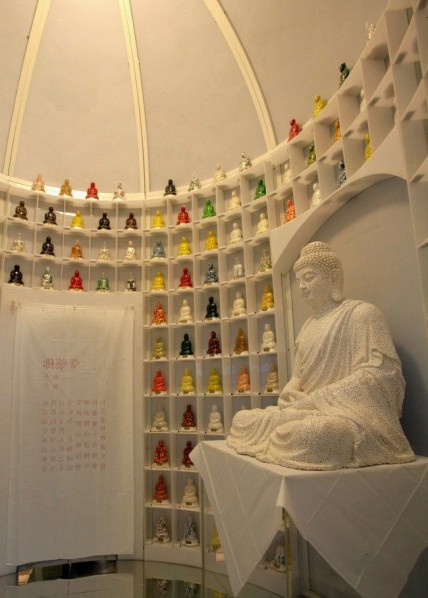
Zhan Wang, Buddhist Medicine (2004 – 2006)
“Buddhist Medicine” (2004 – 2006): Putting Buddha and medicine together and making it both Buddha and medicine; putting pharmacy along with the Buddhist court together and making it both a pharmacy and a Buddhist court. People are used to treating spirit and material separately, such as religion solving a spiritual problem and hospitals solving physical problems. However, we clearly noticed that it’s hard to divide those two aspects. Therefore I want to explain that spirit and material are inseparable, this world is not either or.
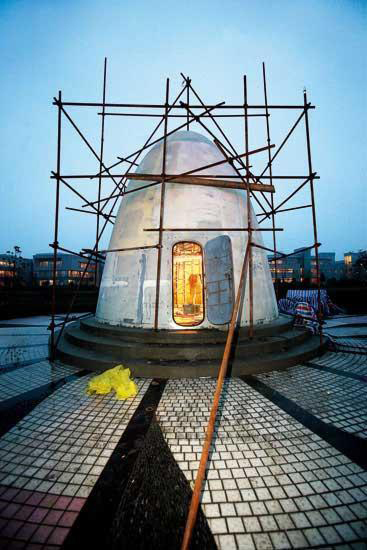
Zhan Wang, Electronic Temple(2006) 01
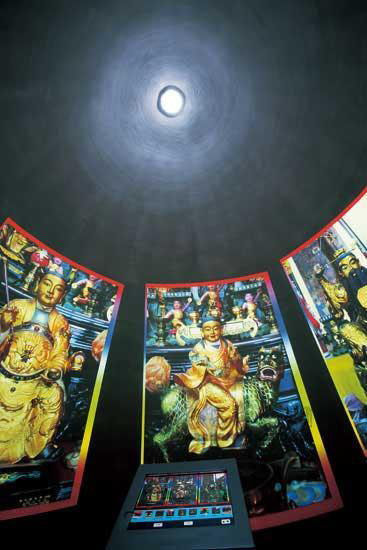
Zhan Wang, Electronic Temple(2006) 02
"Electronic Temple "(2006): We know that, in traditional inhabited places, even each village or town, there are religious venues, it is indispensible content of building a civilized lifestyle. But new community life can hardly meet this demand, although there’s one or two churches or temples, it’s impossible to meet an international community with people living together of different religious belief. “Electronic Temple” solved this problem with it’s own interpretation.
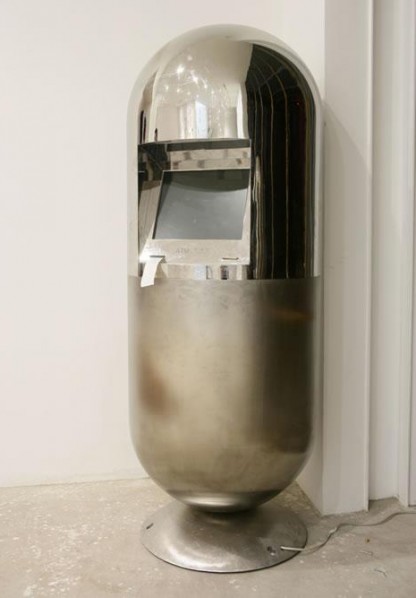
Zhan Wang, ATM Deity Search Engine, 2008; installation, 220×80cm
"ATM Deity Search Engine" (2008): the thinking and behavior of people has been influenced by a mirror of this world — the world of deity for a thousand years of civilization. That is to say, the contradiction of deity directly influenced human’s contradiction. Therefore, without solving the deity’s problem, the human problem cannot be solved. As a result, a new world view could be born by using this new deity search engine, first deities should be all equal, and then people can be equal. Ideally you could naturally accept this idea by using this search engine; it might become a new standard of value from a human point of view. When the world of deity is peaceful, then the human world is peaceful.
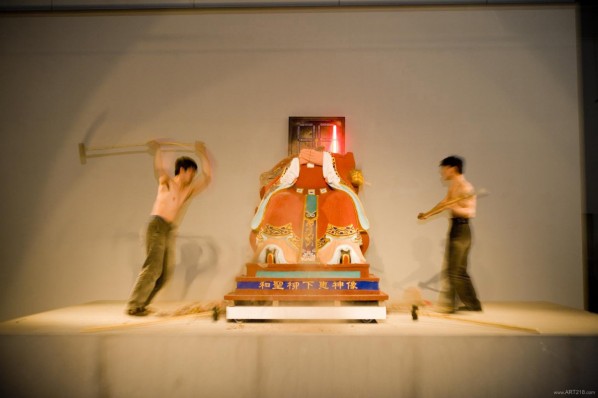
Zhan Wang, 86 Divine Figures (2008)
"86 Divine Figures" (2008): Hope this sculpture is no divine figure of ancestors or a conceptual sculpture. When it’s placed on an ancestral shrine, the people from that homeland will enter in a conceptual process of thinking when they are worshiping. The descendents must ask: what is the clay ruin beneath the seated figure? Why are they all smashed? Why is the 86th one not smashed yet?
Zhan Wang said “Why are we constantly breaking and reconstructing? Can’t we set things up without breaking things?” Zhan Wang is always in between ‘setting up’ and ‘breaking’, in his view, both of them lose ‘normality’. The ‘normality’ is: things will be broken after they are formed and formed after they are broken. It is in the circulation of ‘breaking and setting up’, the world continues its existence. It’s biased to see just ‘breaking’ or ‘setting up’.
Zhan Wang wanted to confront the idea of a ‘round world’. It’s more accurate to end this part with Zhan Wang’s own words “Face everything frankly and directly, no matter what birth defect we are carrying, there would be confidence if we confront it without avoidance. Where we are based , we should start from; What we can touch, we should start with; Where our imagination reaches, we should start from; What we can still do, we should start from. Walk forward by one’s own desire, not avoiding, coping with the world of omnibearing with the self of omnibearing, do what you can do!” ——Why We Are Still Confident.
To be continued …




























